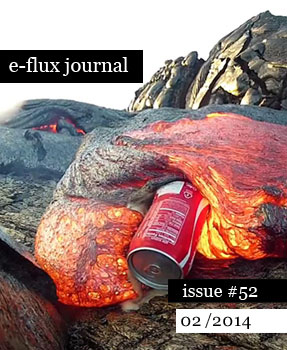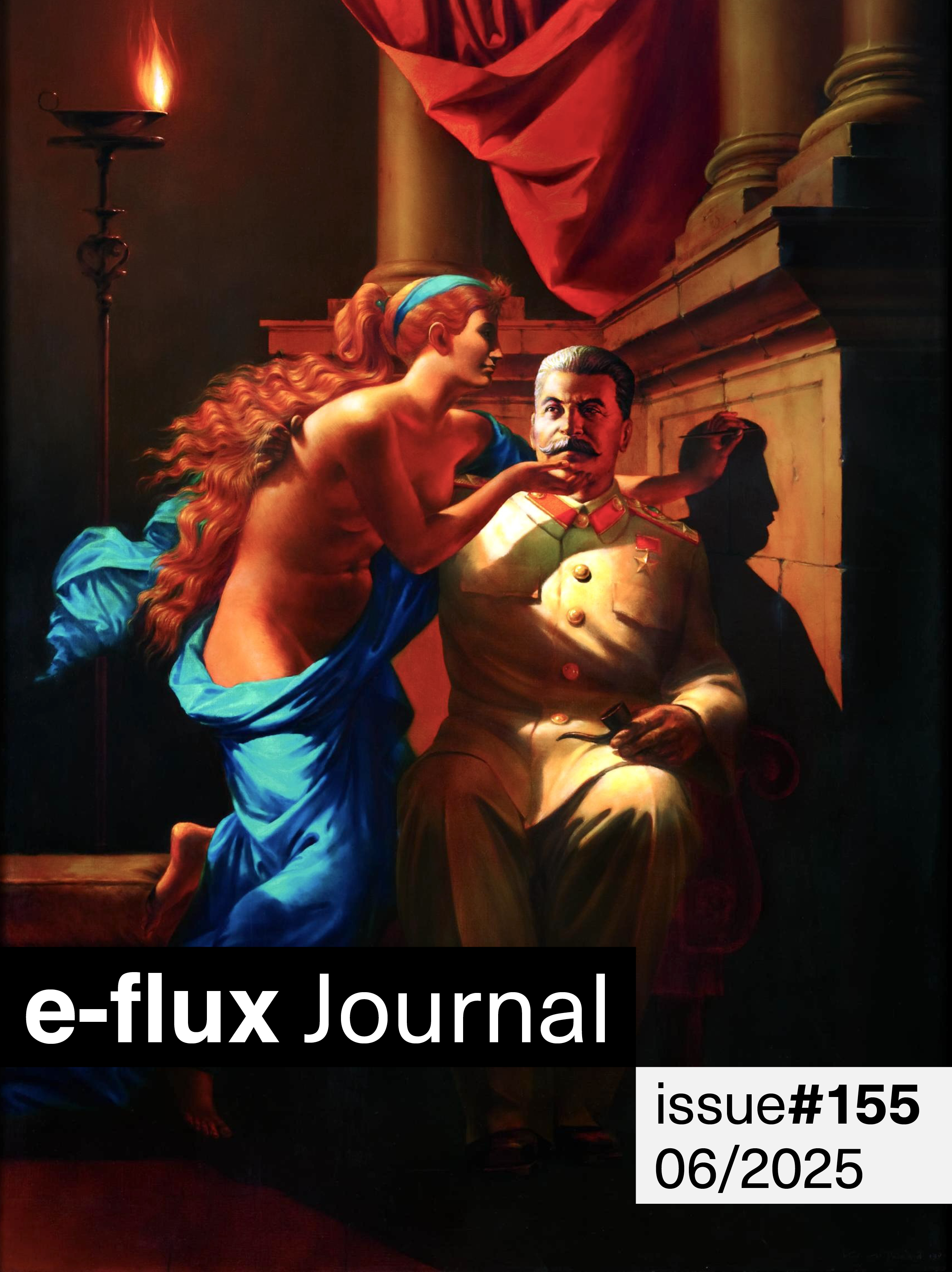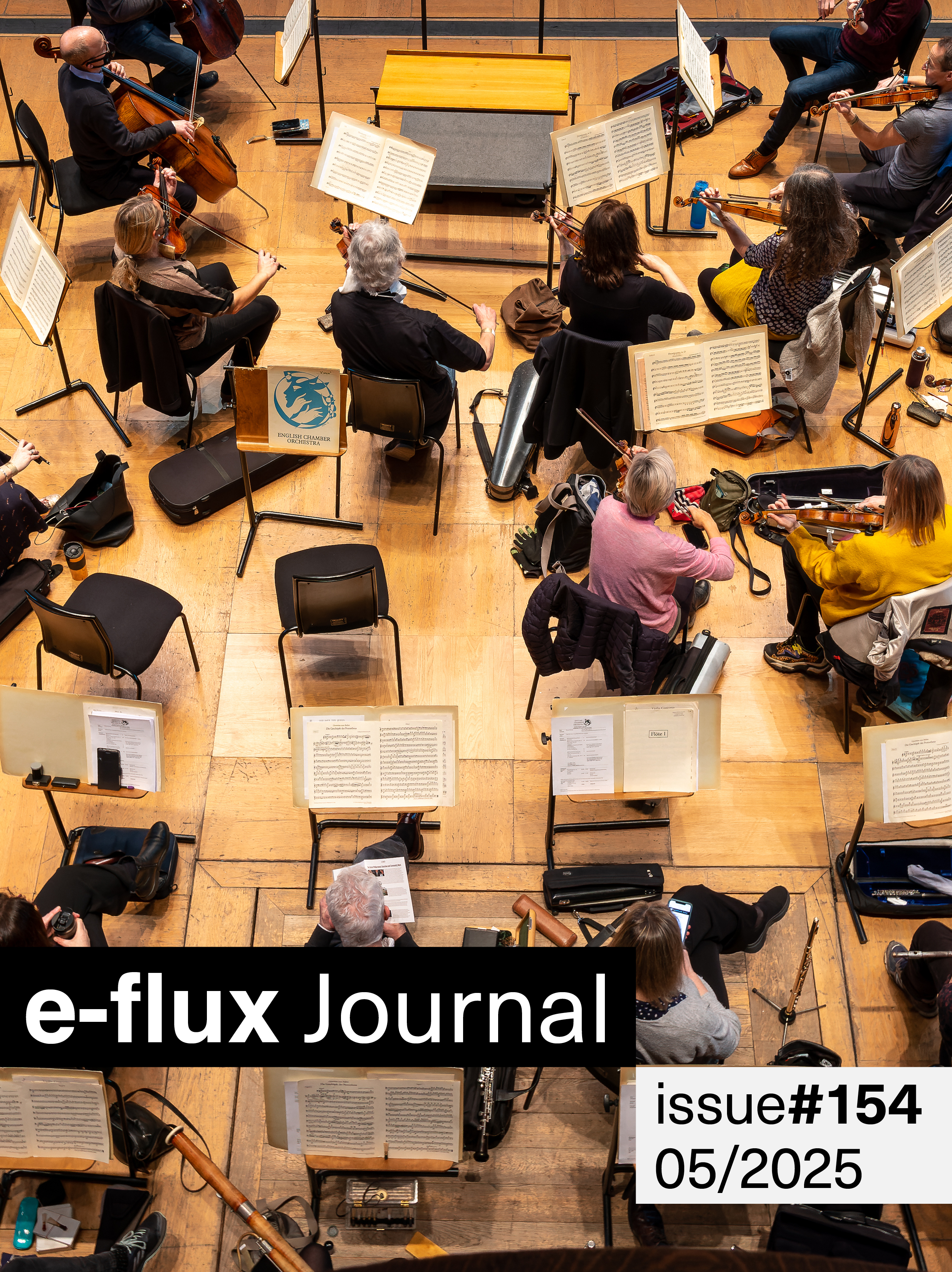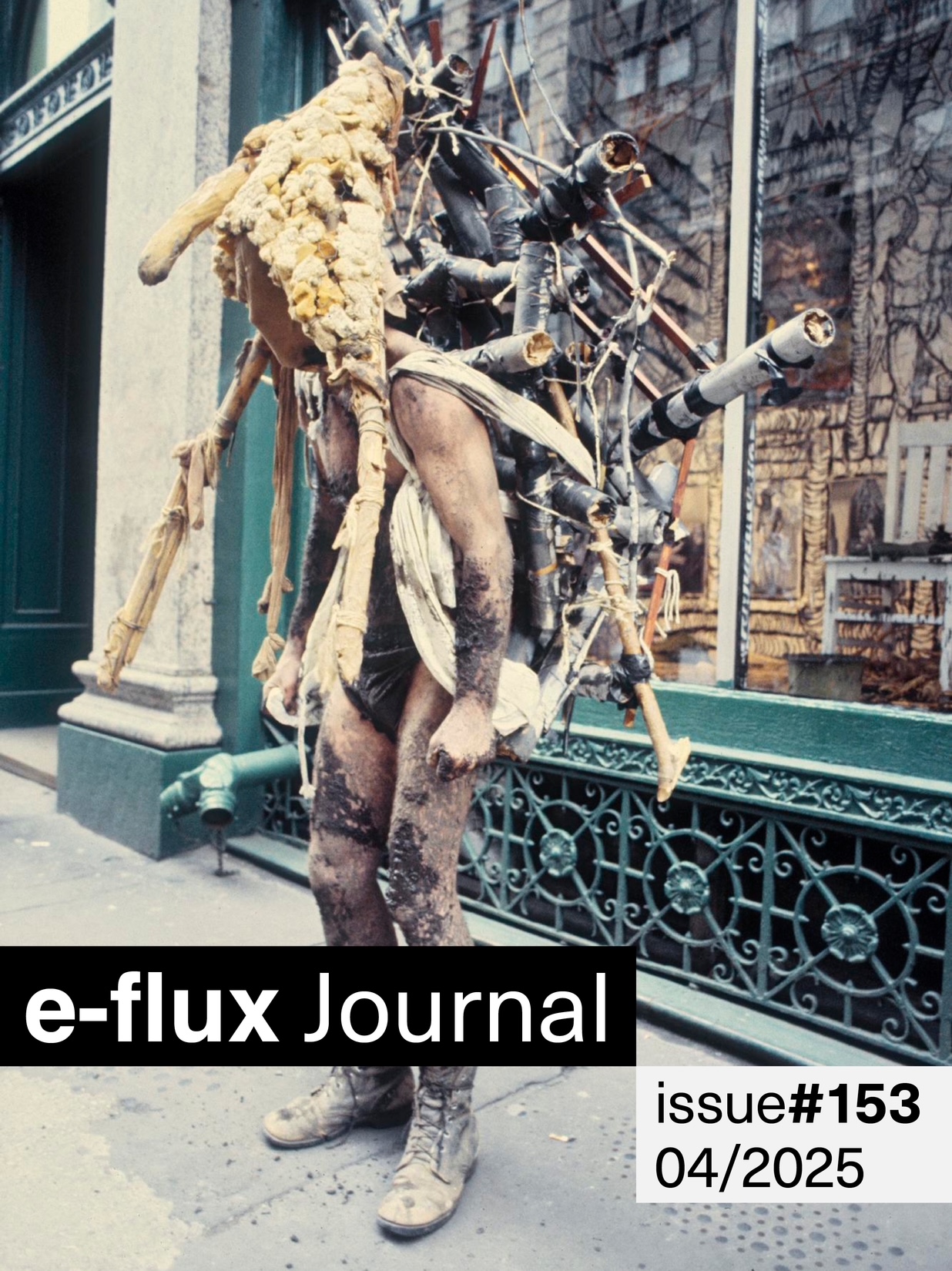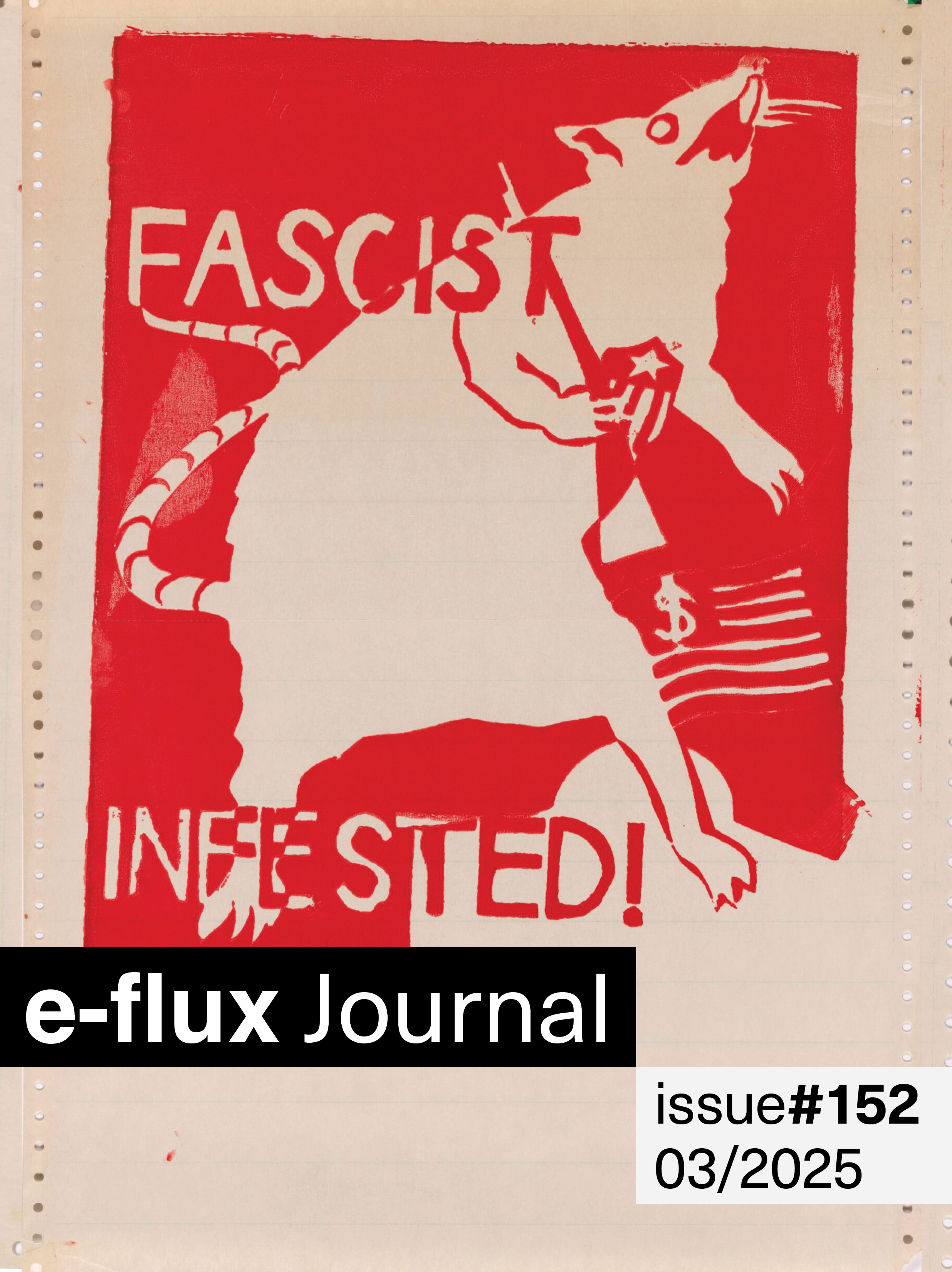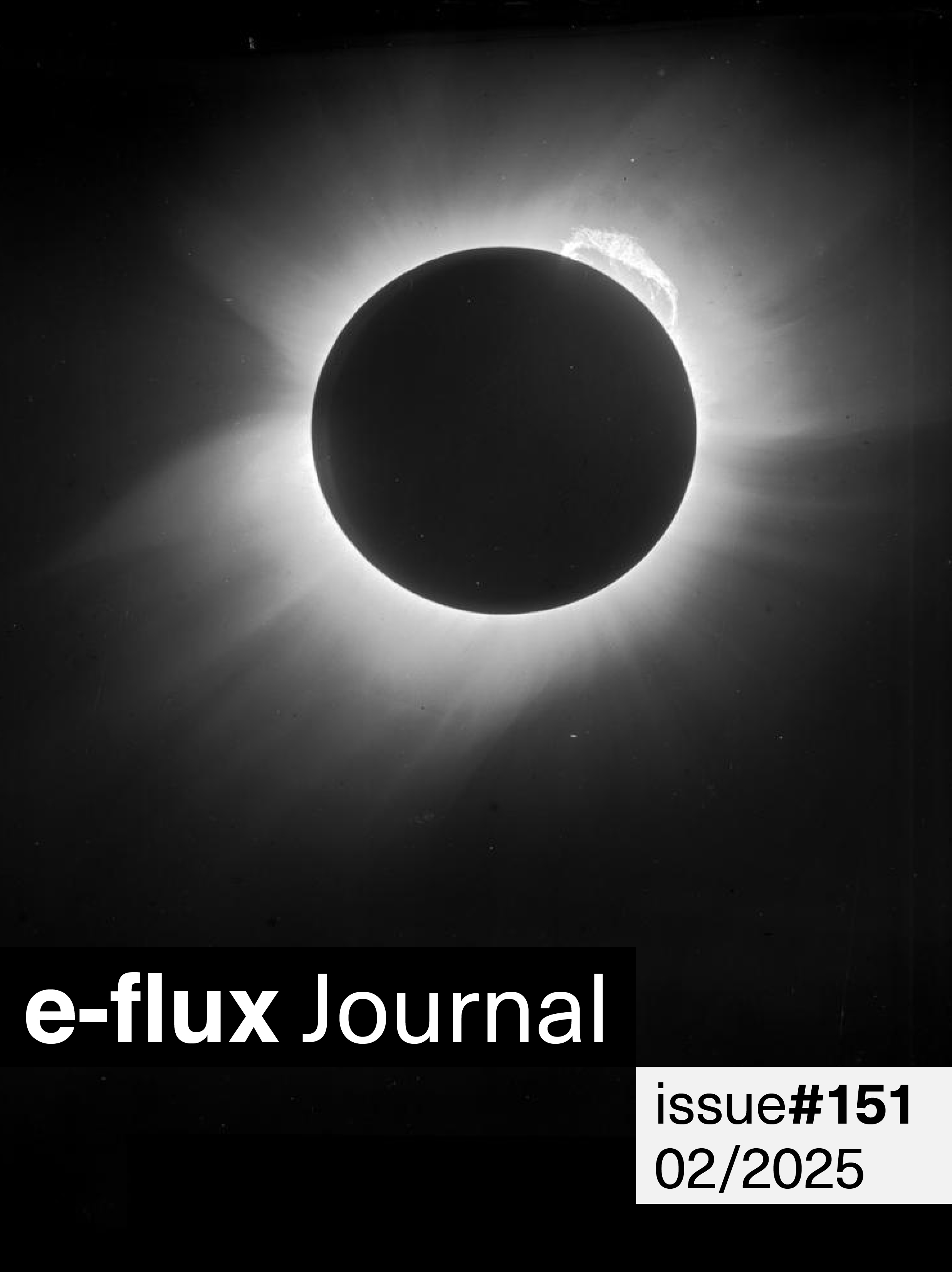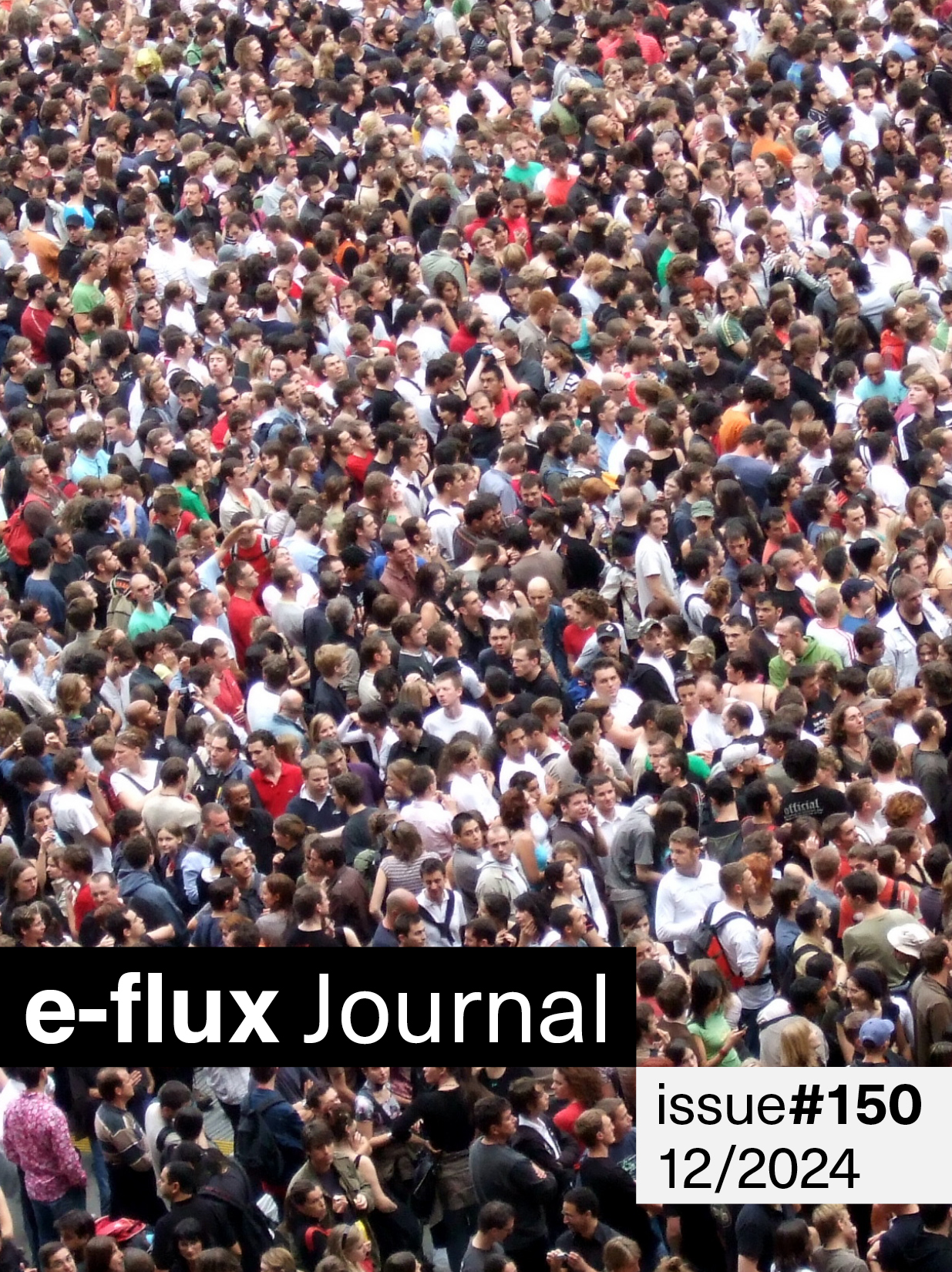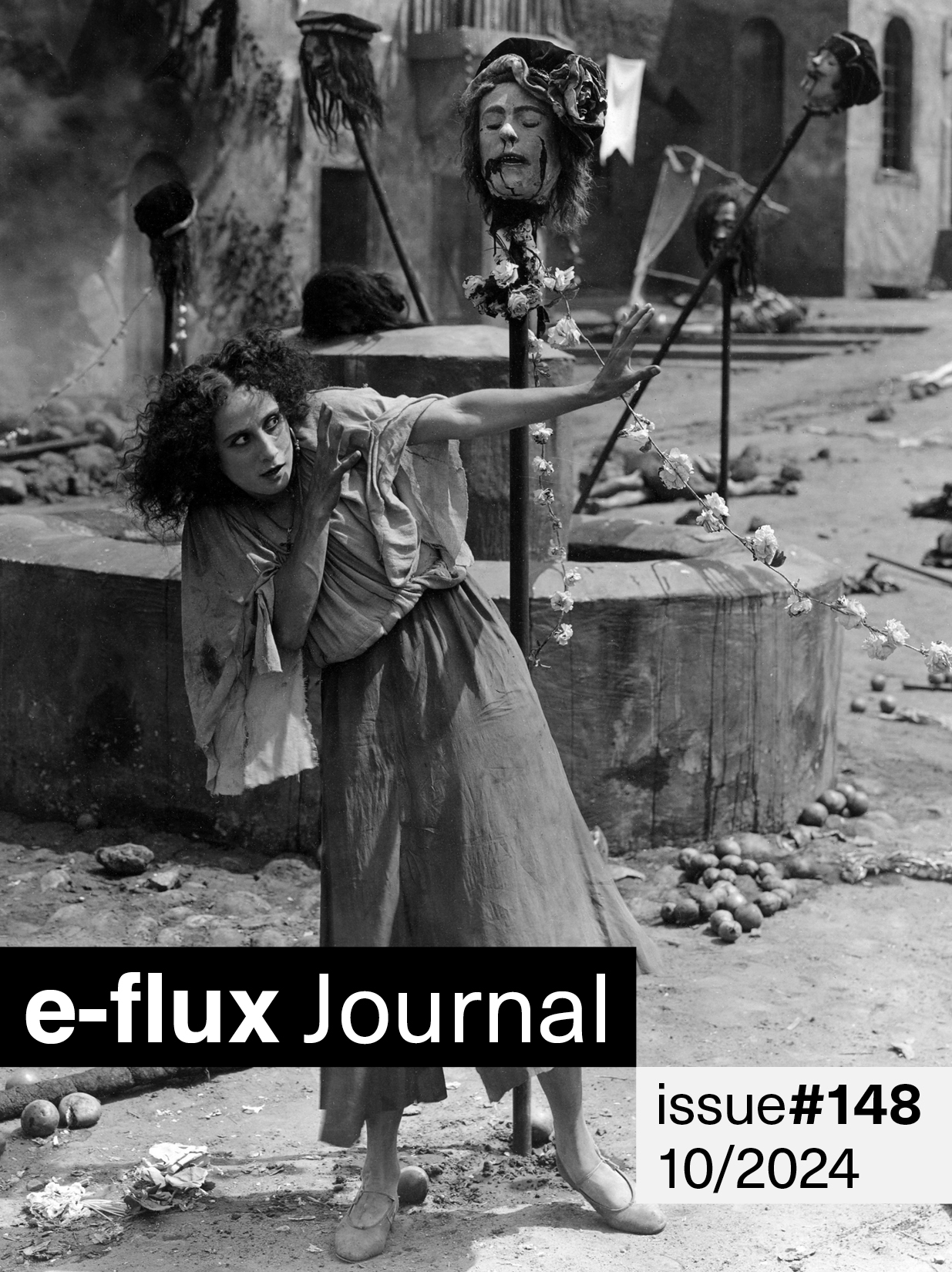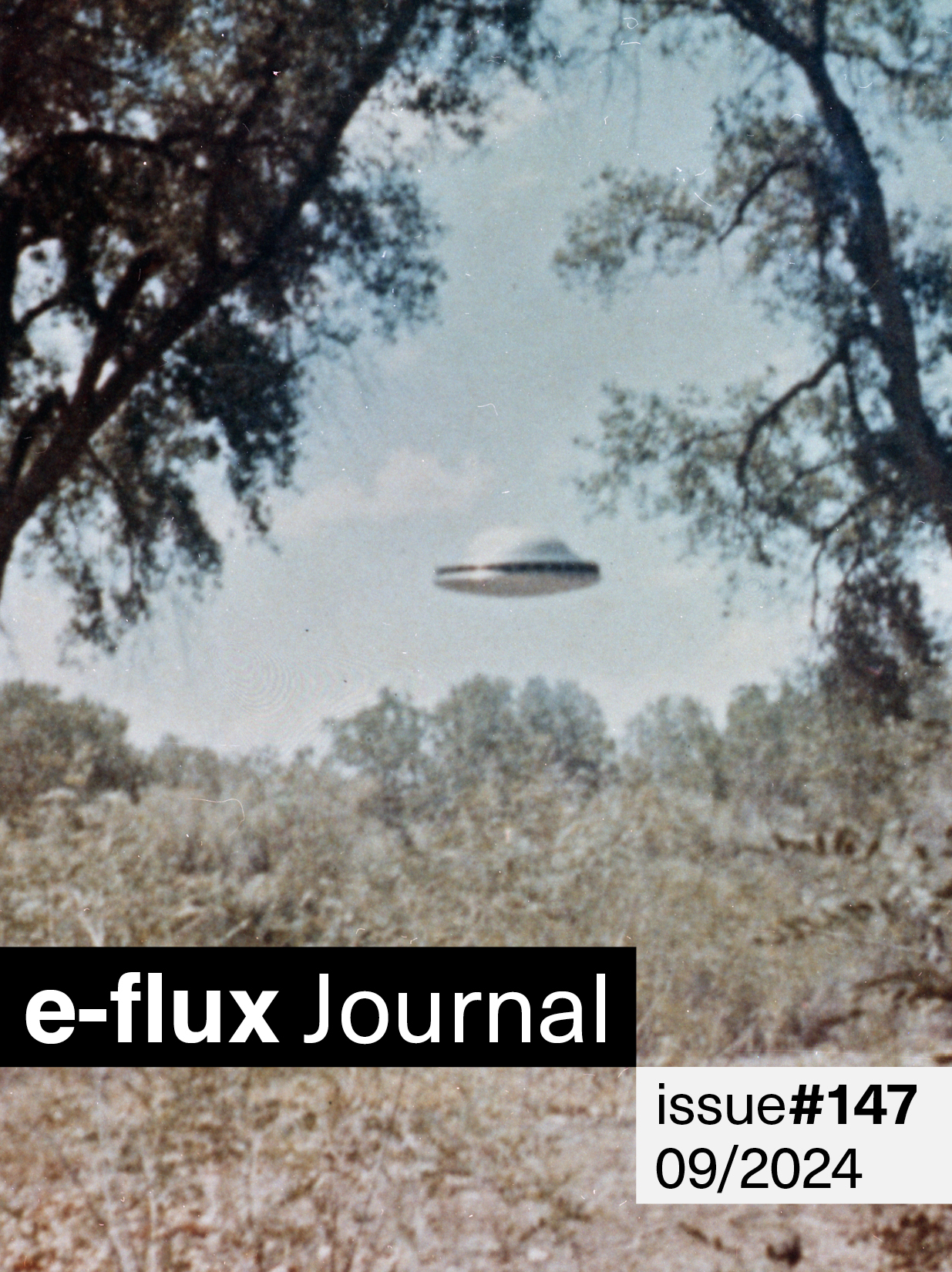e-flux journal issue 52
out now
with Reza Negarestani, Ane Hjort Guttu,
Tom Holert, Tyler Coburn, Jonas Staal,
Antke Engel, Stephen Squibb, and
Pierre Dardot & Christian Laval
www.e-flux.com/issues/52-february-2014
e-flux journal iPad edition is now available.
Free download here.
Neoliberalism began as the idea that economic rationality could be applied as a model of governance in place of political ideology. No more authoritarianism. Just the rational calculation of people’s needs and wants. But now we realize that needs and wants are not rational. They are crazy. And they take place on such vastly different scales that, without any political idea to stabilize desires and render them accountable—even simply in the sense of being legible and comprehensible—we are faced with nothing but irrationality as a governing order. Even logistical mechanisms are only the infrastructural bracketing of a rational order that is actually and profoundly not.
The source of this irrationality is neither capital nor the desire for it. It becomes more and more clear that capital is only a medium for something else which is far more complex. Economists got something fundamentally wrong: they assumed that markets and economic flows were self-regulating. But in getting it wrong, they unleashed a force behind abstract capital that totally unraveled the terms upon which the industrial notion of economy had been operating.
As former modes of governance prove insufficient, new territories—and therefore new economies—open up. We used to have two modes of citizenship, and they were pegged to either soil or blood: jus sangiunis and jus soli. This is what backed colonization and this is what backed the Westphalian model. But that model is gone. The conditions for it will never be there again. Blood and soil fail us, constantly and in turn. Our bloodlines are bad. They are tainted, they are mixed, and they are filthy. Our genealogy is untraceable. Our soil is over-plowed. It is a ghost town, barren and unlovable. And yet, the collapse of the idea of citizenship backed by a blood standard has given way to new modes of citizenship: based in profit, in disaster, or in some impossible conflation of both. We buy passports in Malta. We wash up on the shores of Lampedusa. Hopefully. We are contract labor living in luxury slum compounds in the Gulf. We are aspiring climate refugees. We are Polish plumbers dancing at Berghain.
But what forms of allegiance does all of this assume—to what kind of territory? We have known it all along: the boundaries of our new states are shaped by language. Language is what makes things true by making words spin right. Language is what makes things convincing by making them sound familiar. Language is what settles in and goes to work at fundamental points of ambiguity between symbolic control and material resource. Between command and flow. Between the military and the internet. Between you and your devices; between states. Your passport comes out of a laser printer.
When symbolic calculation and semiotic abstraction mix with real power, they unleash an entirely new way of understanding the limits of both. Not everything is relative. Some things just don’t flow. Some things don’t translate; some things are heavy. The whole point of symbolic games is to mediate these absolute limits. When a crime causes irreparable damage, you need a symbolic equivalence to make up the difference. You can’t always return stolen goods. You can’t stop islands in the South Pacific from going underwater. You can’t bring back the dead. You need to make up for it; you need reparations that spin right. It is less about solving problems than about finding the symbolic resources to move on. Even if financial and computational abstraction regimes convert laws and borders into commodities and psychotic projections of desire, it does not necessarily mean that these things were so stable to begin with. And maybe the role of institutions was always to find the language to mask that very fact, to inscribe authority so deeply that symbols can be absolutely believed. Which is to say, maybe we aren’t so crazy after all.
—Julieta Aranda, Brian Kuan Wood, Anton Vidokle
In this issue:
Reza Negarestani—The Labor of the Inhuman, Part I: Human
Inhumanism is the extended practical elaboration of humanism; it is born out of a diligent commitment to the project of enlightened humanism. As a universal wave that erases the self-portrait of man drawn in sand, inhumanism is a vector of revision. It relentlessly revises what it means to be human by removing its supposed evident characteristics and preserving certain invariances. At the same time, inhumanism registers itself as a demand for construction, to define what it means to be human by treating human as a constructible hypothesis, a space of navigation and intervention.
Ane Hjort Guttu—The Rich Should Be Richer
We are taught that the sun shines on everyone. The sun is one of the best things in life, and the best things in life are free, or so we’ve heard. But that’s not how it is. The sun belongs to someone. The clouds belong to someone. The road, the trees, the houses. The sound of footsteps on the street. It’s all for sale.
Tom Holert—National Heterologies: On the Materiality and Mediality of Flags
To what extent is a flag not only a symbol, but also a medium? Flags exist in different manifestations and materials, from the sewn flag on the mast to the GIF file. In essence, they are artificial, manufactured objects. Sewn together, printed or embroidered cloth-segments, their symbolic effect is a result both of antecedent production—from graphic development to the sewing machine—and of formal and informal use. The flag serves as a vehicle for political-identical argumentation; but it should also be considered in its materiality—as hardware.
Tyler Coburn—Charter Citizen
Theoretically, anyone in the world can migrate to a charter city. It remains the sovereign territory of a host country, but is privately held—as with a case like Singapore, infrastructural and administrative costs are drawn from the revenues of land leasing and value gains. A given charter city sources its rules from a guarantor nation, in the manner that Hong Kong recruits judges from common law jurisdictions, or Mauritius appeals cases to the United Kingdom’s Privy Council.
Jonas Staal—Art. Democratism. Propaganda.
What one could conclude from this is that if we can speak of the art of the world fair in terms of propaganda—keeping the Venice Biennale in mind as our starting point—we should do so not from the superstructural role of the artwork itself, which serves mainly as a decorative function of ideals of civilization and innovation, but in relation to the underlying uncontested base that facilitates this exchange of goods. A further, more interesting conclusion could be drawn relating the United Arab Emirates to the doctrine of democratism, a political construct that dispenses actual electoral, parliamentary representation.
Antke Engel—The Elegantly Strong Triad: Defamiliarizing the Family in Works by LaToya Ruby Frazier and Henrik Olesen
Frazier’s image denotes the ambiguous power relations of this triad in various ways; for one, Mom takes up the powerful position of photographer, image-maker, and framer. Yet Mom also includes her own body in the frame, refusing to let her daughter stand alone. The mother’s pose is ambivalent; she stands erect—her back straight, her shoulders stiff, her chin up—like a young recruit trying to claim authority she doesn’t (yet) convincingly embody.
Stephen Squibb—Genres of Capitalism, Part I
Associated with historical approaches, this genre has a tendency to identify capitalism with a monetary economy, and focuses on exchange relations rather than on relations of production, consumption, or distribution. Generic examples tend to seek “the origins of capitalism in the first encroachments of specifically commercial dealings upon the narrow economic horizons and the supposedly ‘natural economy’ of the medieval world.”
Pierre Dardot and Christian Laval—The New Way of the World, Part II: The Performance/Pleasure Apparatus
The “unbounded world” does not pertain to some return to “nature,” but is the effect of a particular institutional regime that regards any limit as potentially already outmoded. Far removed from the model of a central power directly controlling subjects, the performance/pleasure apparatus is apportioned into diversified mechanisms of control, evaluation, and incentivization and pertains to all the cogs of production, all modes of consumption, and all forms of social relations.
The print edition of e-flux journal can now be found at:
Amsterdam: De Appel arts centre / Rijksakademie van beeldende kunsten Andratx: CCA Andratx Antwerp: M HKA Museum van Hedendaagse Kunst Athens: OMMU Århus: Aarhus Art Building Auckland: split/fountain Austin: Arthouse at the Jones Center Baden-Baden: Staatliche Kunsthalle Baden-Baden Banff: Walter Phillips Gallery, The Banff Centre Barcelona: Arts Santa Monica / MACBA Basel: Kunsthalle Basel, Museum fur Gegenwartskunst Beijing and Guangzhou: Vitamin Creative Space Beirut: 98weeks Belgrade: Cultural Center of Belgrade Bergen: Bergen Kunsthall / Rakett Berlin: b_books / Berliner Künstlerprogramm – DAAD / do you read me? / Haus Der Kulturen der Welt / NBK, Neuer Berliner Kunstverein / Pro qm Berlin and Zurich: Motto Bern: Kunsthalle Bern / Lehrerzimmer Bialystok: Arsenal Gallery Bielefeld: Bielefelder Kunstverein Birmingham: Eastside Projects / Ikon Gallery Bologna: MAMbo – Museo d’Arte Moderna di Bologna Bregenz: Kunsthaus Bregenz Bristol: Arnolfini Brussels: Wiels Bucharest: National Museum of Contemporary Art Bucharest (MNAC) / Pavilion Unicredit Cairo: Contemporary Image Collective (CIC) / Townhouse Gallery Calgary: The New Gallery Cambridge: Wysing Arts Center Castello: Espai d’art contemporani de Castelló (EACC) Chicago: Graham Foundation / Logan Center, University of Chicago / The Renaissance Society Cologne: Kölnischer Kunstverein Copenhagen: Overgaden Derry: CCA Derry~Londonderry Dubai: Traffic Dublin: Dublin City, The Hugh Lane / Project Arts Centre Dusseldorf: Kunstverein für die Rheinlande und Westfalen Eindhoven: Van Abbemuseum Farsta: Konsthall C Frankfurt: Städelschule / Portikus Gdansk: Centrum Sztuki Współczesnej Łaźnia Genève: Centre de la photographie Ghent: S.M.A.K. Giza: Beirut Glasgow: CCA Centre for Contemporary Arts / Sculpture Studios Graz: Grazer Kunstverein / Kunsthaus Graz / para_SITE Gallery Grijon: LABoral Centre for Art and Creative Industries Hamburg: Kunstverein Helsinki: Museum of Contemporary Art Kiasma Hobart: CAST Gallery / INFLIGHT Hong Kong: Asia Art Archive Istanbul: BAS / Galeri Zilberman / DEPO / SALT Iași: theartstudent at the University of Fine Arts, Iași Innsbruck: Galerie im Taxispalais Johannesburg: Center for Historical Reenactments Kristiansand: SKMU Sørlandet Art Museum Kansas City: La Cucaracha Press Klagenfurt: Press Kunstraum Lakeside Leeds: Pavilion Lisbon: Maumaus, Escola de Artes Visuais / Oporto / Kunsthalle Lissabon Loughborough: Radar, Loughborough University Ljubljana: Moderna Galerija Llandudno: Mostyn London: Architectural Association / Bedford Press / Gasworks / ICA / Serpentine Gallery / The Showroom / Visiting Arts Los Angeles: REDCAT Luxembourg: Casino Luxembourg Madrid: Brumaria / CA2M / Pensart Maastricht: Jan van Eyck Academie Marfa: Ballroom Marfa Melbourne: Monash University Museum of Art / World Food Books Mexico City: Proyectos Monclova Milan: Fondazione Nicola Trussardi, Hangar Bicocca Milton Keynes: Milton Keynes Gallery Minneapolis: Walker Art Center Moncton: Fixed Cog Hero (a bicycle courier company) Montreal: Canadian Centre for Architecture Moscow: Garage Center for Contemporary Culture Munich: Museum Villa Stuck / Walther Koenig Bookshop, Haus der Kunst Munich New Delhi: Sarai CSDS New York: e-flux / Independent Curators International (ICI) / McNally Jackson Books / Printed Matter, Inc Nottingham: Nottingham Contemporary Omaha: Bemis Center for Contemporary Arts Oslo: Kunstnernes hus Oxford: Modern Art Oxford Padona: Fondazione March Paris: castillo/corrales – Section 7 Books / Centre Pompidou / Les Laboratoires d’Aubervilliers Philadelphia: Bodega Pori: Pori Art Museum Porto: Museu de Arte Contemporânea de Serralves Portland: Portland Institute for Contemporary Art (PICA) / Publication Studio Prague: Dox Centre for Contemporary Art Prishtina: Stacion – Center for Contemporary Art Prishtina Providence: AS220 Reykjavik: Reykjavik Art Museum Riga: Kim? Rio de Janeiro: A Gentil Carioca Rome: MACRO Museo d’Arte Contemporanea Roma / Opera Rebis Rotterdam: Piet Zwart Institute / Witte de With Saint-Nazaire: Le Grand Cafe, Centre d’art Contemporain Salzburg: Salzburger Kunstverein San Antonio: Artpace São Paulo: Kunsthalle São Paulo / Master in Visual Arts, Faculdade Santa Marcelina Sarajevo: Sarajevo Center for Contemporary Art Seoul: The Books / The Book Society Sherbrooke: Foreman Art Gallery of Bishop’s University Skopje: Press to Exit Project Space Sofia: ICA Sofia / Sofia Art Gallery St Erme Outre et Ramecourt: Performing Arts Forum St Louis: White Flag Projects Stockholm: Bonniers Konsthall / IASPIS / Index / Konstfack, University College of Art, Craft and Design Stuttgart: Württembergischer Kunstverein Stuttgart Sydney: Artspace Tallinn: Kumu Art Museum of Estonia The Hague: Stroom Den Haag Toronto: Art Metropole / Mercer Union / The Power Plant Torun: Centre of Contemporary Art Znaki Czasu in Torun Toowoomba: Raygun Contemporary Art Projects Trieste: Trieste Contemporanea Umeå: Bildmuseet, Umeå University Utrecht: BAK, basis voor actuele kunst / Casco – Office for Art, Design and Theory Vaduz: Kunstmuseum Liechtenstein Valletta: Malta Contemporary Art Foundation Vancouver: ARTSPEAK / Morris and Helen Belkin Art Gallery, University of British Columbia / Fillip / Motto / READ Books, Charles H. Scott Gallery, Emily Carr University of Art and Design Vienna: Salon für Kunstbuch, Belvedere Gallery Vigo: MARCO, Museo de Arte Contemporanea de Vigo Vilnius: Contemporary Art Centre (CAC) Vitoria-Gasteiz: Montehermoso Kulturunea Visby: BAC, Baltic Art Center Warsaw: Zachęta Narodowa Galeria Sztuki / Zachęta National Gallery of Art Wiesbaden: Nassauischer Kunstverein (NKV) Yerevan: Armenian Center for Contemporary Experimental Art, NPAK Zagreb: Galerija Miroslav Kraljevic / Gallery Nova / Institute for Duration, Location and Variables, DeLVe Zurich: Postgraduate Program in Curating, Zürich University of the Arts / Shedhalle / White Space.
